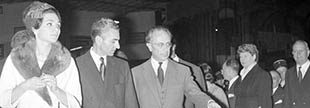Despite his significance, Pasolini’s works frequently sparked controversy. His explorations of sexuality, religion, and societal norms were often seen as subversive, pushing boundaries that many considered inappropriate for public art. His films touched on taboo subjects and were often critical of the bourgeoisie and religious institutions. Thus, when he came to Isfahan in 1972 to work on The Flower of One Thousand and One Nights, Pasolini was already a polarizing figure.
The Flower of One Thousand and One Nights and Its Filming in Iran
Pasolini’s film The Flower of One Thousand and One Nights was part of his “Trilogy of Life,” a series that included adaptations of classic tales such as The Decameron and The Canterbury Tales. The project aimed to celebrate human sexuality and freedom in a way that contrasted sharply with Western puritanical norms. This adaptation of One Thousand and One Nights, a collection of Middle Eastern folklore, was visually rich and unapologetically sensual, embodying Pasolini’s fascination with ancient stories and their portrayal of human desires.
Choosing Isfahan, a city known for its rich cultural heritage, stunning architecture, and Islamic history, as a filming location for scenes of One Thousand and One Nights added an aesthetic authenticity that Pasolini cherished. Among the most famous structures in Isfahan are the Shah Mosque (also known as Imam Mosque) and Jameh Mosque, which Pasolini used as backdrops. The colorful mosaics and grandiose structures of these mosques embodied the architectural splendor Pasolini sought to capture in his film. However, this choice also ignited a significant backlash from religious authorities and conservative factions within the city.

